Hemp
Hemp, or industrial hemp, is a variety of the Cannabis sativa plant species that is grown specifically for the industrial uses of its derived products.[1] It is one of the fastest growing plants[2] and was one of the first plants to be spun into usable fiber 50,000 years ago.[3] It can be refined into a variety of commercial items, including paper, textiles, clothing, biodegradable plastics, paint, insulation, biofuel, food, and animal feed.[4][5]
| Part of a series on |
| Cannabis |
|---|
 |
|
|
|
|
Regional
|
|
Variants |
|
Although cannabis as a drug and industrial hemp both derive from the species Cannabis sativa and contain the psychoactive component tetrahydrocannabinol (THC), they are distinct strains with unique phytochemical compositions and uses.[6] Hemp has lower concentrations of THC and higher concentrations of cannabidiol (CBD), which decreases or eliminates its psychoactive effects.[6] The legality of industrial hemp varies widely between countries. Some governments regulate the concentration of THC and permit only hemp that is bred with an especially low THC content.[7][8]
Etymology
The etymology is uncertain but there appears to be no common Proto-Indo-European source for the various forms of the word; the Greek term κάνναβις (kánnabis) is the oldest attested form, which may have been borrowed from an earlier Scythian or Thracian word.[9][10] Then it appears to have been borrowed into Latin, and separately into Slavic and from there into Baltic, Finnish, and Germanic languages.[11]
In the Germanic languages, following Grimm's law, the "k" would have changed to "h" with the first Germanic sound shift,[9][12] giving Proto-Germanic *hanapiz, after which it may have been adapted into the Old English form, hænep, henep.[9] Barber (1991) however, argued that the spread of the name "kannabis" was due to its historically more recent plant use, starting from the south, around Iran, whereas non-THC varieties of hemp are older and prehistoric.[11] Another possible source of origin is Assyrian qunnabu, which was the name for a source of oil, fiber, and medicine in the 1st millennium BC.[11]
Cognates of hemp in other Germanic languages include Dutch hennep, Danish and Norwegian hamp, Saterland Frisian Hoamp, German Hanf, Icelandic hampur and Swedish hampa. In those languages "hemp" can refer to either industrial fiber hemp or narcotic cannabis strains.[9]
Uses
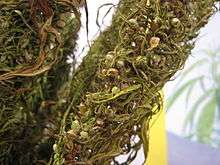
Hemp is used to make a variety of commercial and industrial products, including rope, textiles, clothing, shoes, food, paper, bioplastics, insulation, and biofuel.[4] The bast fibers can be used to make textiles that are 100% hemp, but they are commonly blended with other fibers, such as flax, cotton or silk, as well as virgin and recycled polyester, to make woven fabrics for apparel and furnishings. The inner two fibers of the plant are woodier and typically have industrial applications, such as mulch, animal bedding, and litter. When oxidized (often erroneously referred to as "drying"), hemp oil from the seeds becomes solid and can be used in the manufacture of oil-based paints, in creams as a moisturizing agent, for cooking, and in plastics. Hemp seeds have been used in bird feed mix as well.[13] A survey in 2003 showed that more than 95% of hemp seed sold in the European Union was used in animal and bird feed.[14]
Food
| Nutritional value per 100 g (3.5 oz) | |
|---|---|
| Energy | 2,451 kJ (586 kcal) |
4.67 g | |
| Sugars | 1.50 g 0.07 g |
| Dietary fiber | 4.0 g |
48.75 g | |
| Saturated | 4.600 g |
| Trans | 0 g |
| Monounsaturated | 5.400 g |
| Polyunsaturated | 38.100 g 9.301 g 28.698 g |
31.56 g | |
| Tryptophan | 0.369 g |
| Threonine | 1.269 g |
| Isoleucine | 1.286 g |
| Leucine | 2.163 g |
| Lysine | 1.276 g |
| Methionine | 0.933 g |
| Cystine | 0.672 g |
| Phenylalanine | 1.447 g |
| Tyrosine | 1.263 g |
| Valine | 1.777 g |
| Arginine | 4.550 g |
| Histidine | 0.969 g |
| Alanine | 1.528 g |
| Aspartic acid | 3.662 g |
| Glutamic acid | 6.269 g |
| Glycine | 1.611 g |
| Proline | 1.597 g |
| Serine | 1.713 g |
| Vitamins | Quantity %DV† |
| Vitamin A equiv. | 0% 1 μg0% 7 μg |
| Vitamin A | 11 IU |
| Thiamine (B1) | 111% 1.275 mg |
| Riboflavin (B2) | 24% 0.285 mg |
| Niacin (B3) | 61% 9.200 mg |
| Vitamin B6 | 46% 0.600 mg |
| Folate (B9) | 28% 110 μg |
| Vitamin B12 | 0% 0 μg |
| Vitamin C | 1% 0.5 mg |
| Vitamin E | 5% 0.80 mg |
| Minerals | Quantity %DV† |
| Calcium | 7% 70 mg |
| Copper | 80% 1.600 mg |
| Iron | 61% 7.95 mg |
| Magnesium | 197% 700 mg |
| Manganese | 362% 7.600 mg |
| Phosphorus | 236% 1650 mg |
| Potassium | 26% 1200 mg |
| Sodium | 0% 5 mg |
| Zinc | 104% 9.90 mg |
| Other constituents | Quantity |
| Water | 4.96 g |
| Cholesterol | 0 mg |
| |
| †Percentages are roughly approximated using US recommendations for adults. | |
Hemp seeds can be eaten raw, ground into hemp meal, sprouted or made into dried sprout powder. Hemp seeds can also be made into a liquid and used for baking or for beverages such as hemp milk and tisanes.[15] Hemp oil is cold-pressed from the seed and is high in unsaturated fatty acids.[16] The leaves of the hemp plant, while not as nutritional as the seeds, are edible and can be consumed raw as leafy vegetables in salads, and pressed to make juice.[17]
In 2011, the US imported $11.5 million worth of hemp products, mostly driven by growth in the demand for hemp seed and hemp oil for use as ingredients in foods such as granola.[18]
In the UK, the Department for Environment, Food and Rural Affairs treats hemp as a purely non-food crop, but with proper licensing and proof of less than 0.2% THC concentration, hemp seeds can be imported for sowing or for sale as a food or food ingredient.[19] In the US, hemp can be used legally in food products and, as of 2000, was typically sold in health food stores or through mail order.[16]
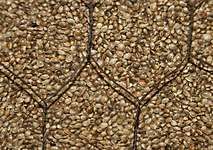 Whole hemp seeds
Whole hemp seeds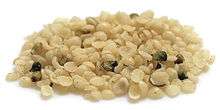 Hulled hemp seeds
Hulled hemp seeds
Nutrition
A 100-gram portion of hulled hemp seeds supplies 586 calories. They contain 5% water, 5% carbohydrates, 49% total fat, and 31% protein. Hemp seeds are notable in providing 64% of the Daily Value (DV) of protein per 100-gram serving.[20] Hemp seeds are a rich source of dietary fiber (20% DV), B vitamins, and the dietary minerals manganese (362% DV), phosphorus (236% DV), magnesium (197% DV), zinc (104% DV), and iron (61% DV). About 73% of the energy in hemp seeds is in the form of fats and essential fatty acids,[20] mainly polyunsaturated fatty acids, linoleic, oleic, and alpha-linolenic acids.[21] The ratio of the 38.100 grams of polyunsaturated fats per 100 grams is 9.301 grams of omega‑3 to 28.698 grams of omega‑6.[22] Typically, the portion suggested on packages for an adult is 30 grams, approximately three tablespoons.
Hemp seeds' amino acid profile is comparable to other sources of protein such as meat, milk, eggs, and soy.[21] Protein digestibility-corrected amino acid scores (PDCAAS), which attempt to measure the degree to which a food for humans is a "complete protein", were 0.49–0.53 for whole hemp seed, 0.46–0.51 for hemp seed meal, and 0.63–0.66 for hulled hemp seed.[23]
Storage
Hemp oil oxidizes and turns rancid within a short period of time if not stored properly;[16] its shelf life is extended when it is stored in a dark airtight container and refrigerated. Both light and heat can degrade hemp oil.
Fiber
Hemp fiber has been used extensively throughout history, with production climaxing soon after being introduced to the New World. For centuries, items ranging from rope, to fabrics, to industrial materials were made from hemp fiber. Hemp was also commonly used to make sail canvas. The word "canvas" is derived from the word cannabis.[24][25] Pure hemp has a texture similar to linen.[26] Because of its versatility for use in a variety of products, today hemp is used in a number of consumer goods, including clothing, shoes, accessories, dog collars, and home wares. For clothing, in some instances, hemp is mixed with lyocell.[27]
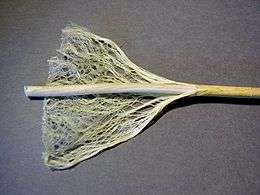 Hemp stem showing fibers
Hemp stem showing fibers 100% Hemp fabric
100% Hemp fabric- Hemp dress
- Hemp dress
.jpg) Hemp shorts
Hemp shorts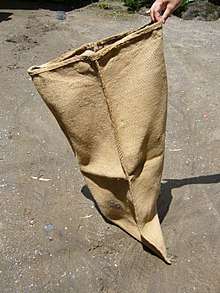 Hemp sack
Hemp sack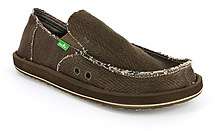 Hemp shoes
Hemp shoes
Building material
Concrete-like blocks made with hemp and lime have been used as an insulating material for construction. Such blocks are not strong enough to be used for structural elements; they must be supported by a brick, wood, or steel frame.[28] However, hemp fibres have been shown to be usable as a replacement for wood for many jobs, including creating durable and breathable homes. The most common use of hemp lime in building is by casting the hemp and lime mix while wet around a timber frame with temporary shuttering, and tamping the mix to form a firm mass; after the removal of the temporary shuttering, the solidified hemp mix is then ready to be plastered with a lime plaster.[29]
The first example of the use of hempcrete was in 1986 in France with the renovation of the Maison de la Turquie in Nogent-sur-Seine by the innovator Charles Rasetti.[30] In the UK hemp lime was first used in 2000 for the construction of two test dwellings in Haverhill.[31] Designed by Modece Architects,[32] who pioneered hemp's use in UK construction, the hemp houses were monitored in comparison with other standard dwellings by BRE. Completed in 2009, the Renewable House is one of the most technologically advanced made from hemp-based materials.[33] The first US home made of hemp-based materials was completed in August 2010 in Asheville, North Carolina.[34]
A panellized system of hemp-lime panels for use in building construction is currently under test in a European Union-funded research collaboration led by the University of Bath. The panels are being designed to assure high-quality construction, rapid on-site erection, optimal hygrothermal performance from day one, and energy- and resource-efficient buildings. The 36-month work program aims to refine product and manufacturing protocols and produce data for certification and marketing, warranty, insurance cover, and availability of finance. It also includes the development of markets in Britain, France, and Spain.[35]
Hemp is used as an internal plaster and is a mixture of hemp hurd (shive) mixed with larger proportions of a lime-based binder. Hemp plaster has insulative qualities.[36]
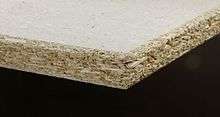 Hemp fiber board
Hemp fiber board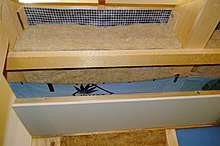 Hemp thermal insulation
Hemp thermal insulation Hemp interior thermal insulation blocks
Hemp interior thermal insulation blocks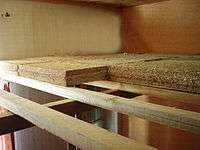 Hemp acoustic ceiling insulation
Hemp acoustic ceiling insulation Concrete block made with hemp in France
Concrete block made with hemp in France
Plastic and composite materials
A mixture of fiberglass, hemp fiber, kenaf, and flax has been used since 2002 to make composite panels for automobiles.[37] The choice of which bast fiber to use is primarily based on cost and availability. Various car makers are beginning to use hemp in their cars, including Audi, BMW, Ford, GM, Chrysler, Honda, Iveco, Lotus, Mercedes, Mitsubishi, Porsche, Saturn, Volkswagen[38] and Volvo. For example, the Lotus Eco Elise[39] and the Mercedes C-Class both contain hemp (up to 20 kg in each car in the case of the latter).[40]
 Hemp plastic interior of a car door
Hemp plastic interior of a car door Hemp plastic automobile glove box
Hemp plastic automobile glove box Hemp plastic column, automobile
Hemp plastic column, automobile Hemp composite sink basin
Hemp composite sink basin
Paper
Hemp paper are paper varieties consisting exclusively or to a large extent from pulp obtained from fibers of industrial hemp. The products are mainly specialty papers such as cigarette paper,[41] banknotes and technical filter papers.[42] Compared to wood pulp, hemp pulp offers a four to five times longer fibre, a significantly lower lignin fraction as well as a higher tear resistance and tensile strength. However, production costs are about four times higher than for paper from wood,[43] since the infrastructure for using hemp is underdeveloped. If the paper industry were to switch from wood to hemp for sourcing its cellulose fibers, the following benefits could be utilized:
- Hemp yields three to four times more usable fibre per hectare per annum than forests, and hemp doesn't need pesticides or herbicides.[44]
- Hemp has a much faster crop yield. It takes about 3-4 months for hemp stalks to reach maturity,[45] while trees can take between 20 to 80 years. Not only does hemp grow at a faster rate, but it also contains a high level of cellulose.[46] This quick return means that paper can be produced at a faster rate if hemp were used in place of wood.
- Hemp paper does not require the use of toxic bleaching or as many chemicals as wood pulp because it can be whitened with hydrogen peroxide. This means using hemp instead of wood for paper would end the practice of poisoning Earth's waterways with chlorine or dioxins from wood paper manufacturing.[47]
- Hemp paper can be recycled up to 8 times, compared to just 3 times for paper made from wood pulp.[48]
- Compared to its wood pulp counterpart, paper from hemp fibers resists decomposition and does not yellow or brown with age.[49] It is also one of the strongest natural fibers in the world[50] - one of the reasons for its longevity and durability.
- Several factors favor the increased use of wood substitutes for paper, especially agricultural fibers such as hemp. Deforestation, particularly the destruction of old growth forests, and the world’s decreasing supply of wild timber resources are today major ecological concerns. Hemp's use as a wood substitute will contribute to preserving biodiversity.[51]
However, hemp has had a hard time competing with paper from trees or recycled newsprint. Only the outer part of the stem consists mainly of fibers which are suitable for the production of paper. Numerous attempts have been made to develop machines that efficiently and inexpensively separate useful fibers from less useful fibers, but none have been completely successful. This has meant that paper from hemp is still expensive compared to paper from trees.
Jewelry
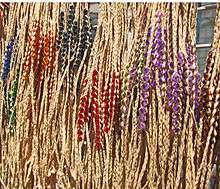
Hemp jewelry is the product of knotting hemp twine through the practice of macramé. Hemp jewellery includes bracelets, necklaces, anklets, rings, watches, and other adornments. Some jewellery features beads made from crystals, glass, stone, wood and bones. The hemp twine varies in thickness and comes in a variety of colors. There are many different stitches used to create hemp jewellery, however, the half knot and full knot stitches are most common.
Cordage
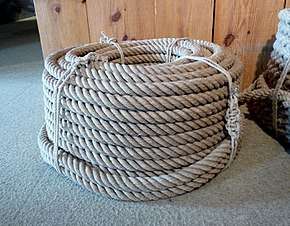
Hemp rope was used in the age of sailing ships, though the rope had to be protected by tarring, since hemp rope has a propensity for breaking from rot, as the capillary effect of the rope-woven fibers tended to hold liquid at the interior, while seeming dry from the outside.[52] Tarring was a labor-intensive process, and earned sailors the nickname "Jack Tar". Hemp rope was phased out when manila rope, which does not require tarring, became widely available. Manila is sometimes referred to as Manila hemp, but is not related to hemp; it is abacá, a species of banana.
Animal bedding
Hemp shives are the core of the stem, hemp hurds are broken parts of the core. In the EU, they are used for animal bedding (horses, for instance), or for horticultural mulch.[53] Industrial hemp is much more profitable if both fibers and shives (or even seeds) can be used.
Water and soil purification
Hemp can be used as a "mop crop" to clear impurities out of wastewater, such as sewage effluent, excessive phosphorus from chicken litter, or other unwanted substances or chemicals. Additionally, hemp is being used to clean contaminants at the Chernobyl nuclear disaster site, by way of a process which is known as phytoremediation—the process of clearing radioisotopes and a variety of other toxins from the soil, water, and air.[54]
Weed control
Hemp crops are tall, have thick foliage, and can be planted densely, and thus can be grown as a smother crop to kill tough weeds.[55] Using hemp this way can help farmers avoid the use of herbicides, gain organic certification, and gain the benefits of crop rotation. However, due to the plant's rapid and dense growth characteristics, some jurisdictions consider hemp a prohibited and noxious weed, much like Scotch Broom.[56]
 The dense growth of hemp helps kill weeds, even thistle.
The dense growth of hemp helps kill weeds, even thistle.
Biofuels
Biodiesel can be made from the oils in hemp seeds and stalks; this product is sometimes called "hempoline".[57] Alcohol fuel (ethanol or, less commonly, methanol) can be made by fermenting the whole plant.
Filtered hemp oil can be used directly to power diesel engines. In 1892, Rudolf Diesel invented the diesel engine, which he intended to power "by a variety of fuels, especially vegetable and seed oils, which earlier were used for oil lamps, i.e. the Argand lamp."[58][59][60]
Production of vehicle fuel from hemp is very small. Commercial biodiesel and biogas is typically produced from cereals, coconuts, palm seeds, and cheaper raw materials like garbage, wastewater, dead plant and animal material, animal feces and kitchen waste.[61]
Processing
Separation of hurd and bast fiber is known as decortication. Traditionally, hemp stalks would be water-retted first before the fibers were beaten off the inner hurd by hand, a process known as scutching. As mechanical technology evolved, separating the fiber from the core was accomplished by crushing rollers and brush rollers, or by hammer-milling, wherein a mechanical hammer mechanism beats the hemp against a screen until hurd, smaller bast fibers, and dust fall through the screen. After the Marijuana Tax Act was implemented in 1938, the technology for separating the fibers from the core remained "frozen in time". Recently, new high-speed kinematic decortication has come about, capable of separating hemp into three streams; bast fiber, hurd, and green microfiber.
Only in 1997, did Ireland, parts of the Commonwealth and other countries begin to legally grow industrial hemp again. Iterations of the 1930s decorticator have been met with limited success, along with steam explosion and chemical processing known as thermomechanical pulping.
Cultivation

Hemp is usually planted between March and May in the northern hemisphere, between September and November in the southern hemisphere.[62] It matures in about three to four months.[63]
Millennia of selective breeding have resulted in varieties that display a wide range of traits; e.g. suited for a particular environments/latitudes, producing different ratios and compositions of terpenoids and cannabinoids (CBD, THC, CBG, CBC, CBN...etc.), fibre quality, oil/seed yield, etc. Hemp grown for fiber is planted closely, resulting in tall, slender plants with long fibers.[64]
The use of industrial hemp plant and its cultivation was commonplace until the 1900s when it was associated with its genetic sibling a.k.a. Drug-Type Cannabis species (which contain higher levels of psychoactive THC). Influential groups misconstrued hemp as a dangerous "drug",[65] even though hemp is not a recreational drug and has the potential to be a sustainable and profitable crop for many farmers due to hemp's medical, structural and dietary uses.[66][67]
In the United States, the public's perception of hemp as marijuana has blocked hemp from becoming a useful crop and product,"[66] in spite of its vital importance prior to World War II.[67] Ideally, according to Britain's Department for Environment, Food and Rural Affairs, the herb should be desiccated and harvested towards the end of flowering. This early cropping reduces the seed yield but improves the fiber yield and quality.[68] In these strains of industrial hemp* the tetrahydrocannabinol (THC) content would have been very low.[66]
The seeds are sown with grain drills or other conventional seeding equipment to a depth of 1.27 to 2.54 cm (0.5 to 1 in). Greater seeding depths result in increased weed competition. Nitrogen should not be placed with the seed, but phosphate may be tolerated. The soil should have available 89 to 135 kg/ha of nitrogen, 46 kg/ha phosphorus, 67 kg/ha potassium, and 17 kg/ha sulfur. Organic fertilizers such as manure are one of the best methods of weed control.[69]
Cultivars
In contrast to cannabis for medical use, varieties grown for fiber and seed have less than 0.3% THC and are unsuitable for producing hashish and marijuana.[70] Present in industrial hemp, cannabidiol is a major constituent among some 560 compounds found in hemp.[71]
Cannabis sativa L. subsp. sativa var. sativa is the variety grown for industrial use, while C. sativa subsp. indica generally has poor fiber quality and female buds from this variety are primarily used for recreational and medicinal purposes. The major differences between the two types of plants are the appearance, and the amount of Δ9-tetrahydrocannabinol (THC) secreted in a resinous mixture by epidermal hairs called glandular trichomes, although they can also be distinguished genetically.[70][72] Oilseed and fiber varieties of Cannabis approved for industrial hemp production produce only minute amounts of this psychoactive drug, not enough for any physical or psychological effects. Typically, hemp contains below 0.3% THC, while cultivars of Cannabis grown for medicinal or recreational use can contain anywhere from 2% to over 20%.[73]
- Cannabis sativa stem
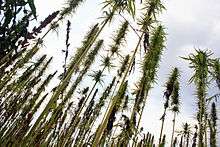 Hemp strains USO-xx and Zolotoniski-xx
Hemp strains USO-xx and Zolotoniski-xx
Harvesting
Smallholder plots are usually harvested by hand. The plants are cut at 2 to 3 cm above the soil and left on the ground to dry. Mechanical harvesting is now common, using specially adapted cutter-binders or simpler cutters.
The cut hemp is laid in swathes to dry for up to four days. This was traditionally followed by retting, either water retting (the bundled hemp floats in water) or dew retting (the hemp remains on the ground and is affected by the moisture in dew and by molds and bacterial action).
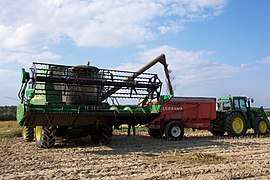 Industrial hempseed harvesting machine in France
Industrial hempseed harvesting machine in France

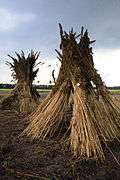
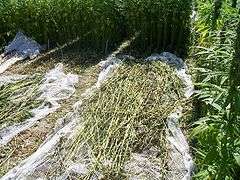 Hemp being harvested
Hemp being harvested
Location and crop rotation
For profitable hemp farming, particularly deep, humus-rich, nutrient-rich soil with controlled water flow is preferable. Waterlogged acidic, compressed or extremely light (sandy) soils primarily affect the early development of plants. Steep and high altitudes of more than 400 m above sea level are best avoided. Hemp is relatively insensitive to cold temperatures and can withstand frost down to −5 °C. Seeds can germinate down to 1–3 °C. Hemp needs a lot of heat, so earlier varieties come to maturation. The water requirement is 300–500 l/kg dry matter. This is around 1/14th that of cotton, which takes between 7,000 and 29,000 l/kg, according to WWF. Roots can grow up to 3 feet into the soil and use water from deeper soil layers.
Hemp benefits crops grown after it. So, it is generally grown before winter cereals. Advantageous changes are high weed suppression, soil loosening by the large hemp root system, and the positive effect on soil tilth. Since hemp is very self-compatible, it can also be grown several years in a row in the same fields (monoculture).
Pests
Several arthropods can cause damage or injury to hemp plants, but the most serious species are associated with the Insecta class. The most problematic for outdoor crops are the voracious stem-boring caterpillars, which include the European corn borer, Ostrinia nubilalis, and the Eurasian hemp borer, Grapholita delineana.[74] As the names imply, they target the stems reducing the structural integrity of the plant.[74] Another lepidopteran, the corn earworm, Helicoverpa zea, is known to damage flowering parts and can be challenging to control.[75] Other foliar pests, found in both indoor and outdoor crops, include the hemp russet mite, Aculops cannibicola, and cannabis aphid, Phorodon cannabis.[75] They cause injury by reducing plant vigour because they feed on the phloem of the plant. Root feeders can be difficult to detect and control because of their below surface habitat. A number of beetle grubs and chafers are known to cause damage to hemp roots, including the flea beetle and Japanese beetle, Popillia Japonica.[74] The rice root aphid, Rhopalosiphum rufiabdominale, has also been reported but primarily affects indoor growing facilities.[75] Integrated pest management strategies should be employed to manage these pests with prevention and early detection being the foundation of a resilient program. Cultural and physical controls should be employed in conjunction with biological pest controls, chemical applications should only be used as a last resort.
Diseases
Hemp plants can be vulnerable to various pathogens, including bacteria, fungi, nematodes, viruses and other miscellaneous pathogens. Such diseases often lead to reduced fiber quality, stunted growth, and death of the plant. These diseases rarely affect the yield of a hemp field, so hemp production is not traditionally dependent on the use of pesticides.
Environmental impact
Hemp is considered by a 1998 study in Environmental Economics to be environmentally friendly due to a decrease of land use and other environmental impacts, indicating a possible decrease of ecological footprint in a US context compared to typical benchmarks.[76] A 2010 study, however, that compared the production of paper specifically from hemp and eucalyptus concluded that "industrial hemp presents higher environmental impacts than eucalyptus paper"; however, the article also highlights that "there is scope for improving industrial hemp paper production".[77] Hemp is also claimed to require few pesticides and no herbicides, and it has been called a carbon negative raw material.[78][79] Results indicate that high yield of hemp may require high total nutrient levels (field plus fertilizer nutrients) similar to a high yielding wheat crop.[80]
Producers
The world-leading producer of hemp is China, which produces more than 70% of the world output. France ranks second with about a quarter of the world production. Smaller production occurs in the rest of Europe, Chile, and North Korea. Over 30 countries produce industrial hemp, including Australia, Austria, Canada, Chile, China, Denmark, Egypt, Finland, Germany, Greece,[81] Hungary, India, Italy, Japan, Korea, Netherlands, New Zealand, Poland, Portugal, Romania, Russia, Slovenia, Spain, Sweden, Switzerland, Thailand, Turkey, the United Kingdom and Ukraine.[82][83]
The United Kingdom and Germany resumed commercial production in the 1990s. British production is mostly used as bedding for horses; other uses are under development. Companies in Canada, the UK, the United States, and Germany, among many others, process hemp seed into a growing range of food products and cosmetics; many traditional growing countries continue to produce textile-grade fibre.
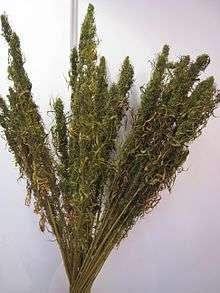
Air-dried stem yields in Ontario have from 1998 and onward ranged from 2.6–14.0 tonnes of dry, retted stalks per hectare (1–5.5 t/ac) at 12% moisture. Yields in Kent County, have averaged 8.75 t/ha (3.5 t/ac). Northern Ontario crops averaged 6.1 t/ha (2.5 t/ac) in 1998. Statistic for the European Union for 2008 to 2010 say that the average yield of hemp straw has varied between 6.3 and 7.3 ton per ha.[84][85] Only a part of that is bast fiber. Around one tonne of bast fiber and 2–3 tonnes of core material can be decorticated from 3–4 tonnes of good-quality, dry-retted straw. For an annual yield of this level is it in Ontario recommended to add nitrogen (N):70–110 kg/ha, phosphate (P2O5): up to 80 kg/ha and potash (K2O): 40–90 kg/ha.[86] The average yield of dry hemp stalks in Europe was 6 ton/ha (2.4 ton/ac) in 2001 and 2002.[14]
FAO argue that an optimum yield of hemp fiber is more than 2 tonnes per ha, while average yields are around 650 kg/ha.[87]
Australia
In the Australian states of Tasmania, Victoria, Queensland, Western Australia, New South Wales, and most recently, South Australia, the state governments have issued licences to grow hemp for industrial use. The first to initiate modern research into the potential of cannabis was the state of Tasmania, which pioneered the licensing of hemp during the early 1990s. The state of Victoria was an early adopter in 1998, and has reissued the regulation in 2008.[88]
Queensland has allowed industrial production under licence since 2002,[89] where the issuance is controlled under the Drugs Misuse Act 1986.[90] Western Australia enabled the cultivation, harvest and processing of hemp under its Industrial Hemp Act 2004,[91] New South Wales now issues licences[92] under a law, the Hemp Industry Regulations Act 2008 (No 58), that came into effect as of 6 November 2008.[93] Most recently, South Australia legalized industrial hemp under South Australia's Industrial Hemp Act 2017, which commenced on 12 November 2017.[94]
Canada
Commercial production (including cultivation) of industrial hemp has been permitted in Canada since 1998 under licenses and authorization issued by Health Canada (9,725 ha in 2004, 5450 ha in 2009).[95]
In the early 1990s, industrial hemp agriculture in North America began with the Hemp Awareness Committee at the University of Manitoba. The Committee worked with the provincial government to get research and development assistance and was able to obtain test plot permits from the Canadian government. Their efforts led to the legalization of industrial hemp (hemp with only minute amounts of tetrahydrocannabinol) in Canada and the first harvest in 1998.[96][97]
In 2017, the cultivated area for hemp in the Prairie provinces include Saskatchewan with more than 56,000 acres (23,000 ha), Alberta with 45,000 acres (18,000 ha), and Manitoba with 30,000 acres (12,000 ha).[98] Canadian hemp is cultivated mostly for its food value as hulled hemp seeds, hemp oils, and hemp protein powders, with only a small fraction devoted to production of hemp fiber used for construction and insulation.[98]
France
France is Europe's biggest producer (and the world's second largest producer) with 8,000 hectares (20,000 acres) cultivated.[99] 70–80% of the hemp fibre produced in 2003 was used for specialty pulp for cigarette papers and technical applications. About 15% was used in the automotive sector, and 5-6% was used for insulation mats. About 95% of hurds were used as animal bedding, while almost 5% was used in the building sector.[14] In 2010/2011, a total of 11,000 hectares (27,000 acres) was cultivated with hemp in the EU, a decline compared with previous year.[85][100]
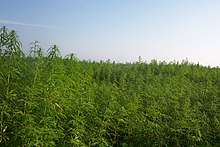 Industrial hemp production in France
Industrial hemp production in France- A hemp maze in France
Russia and Ukraine
.png)
From the 1950s to the 1980s, the Soviet Union was the world's largest producer of hemp (3,000 square kilometres (1,200 sq mi) in 1970). The main production areas were in Ukraine,[101] the Kursk and Orel regions of Russia, and near the Polish border. Since its inception in 1931, the Hemp Breeding Department at the Institute of Bast Crops in Hlukhiv (Glukhov), Ukraine, has been one of the world's largest centers for developing new hemp varieties, focusing on improving fiber quality, per-hectare yields, and low THC content.[102][103]
After the collapse of the Soviet Union, the commercial cultivation of hemp declined sharply. However, at least an estimated 2.5 million acres of hemp grow wild in the Russian Far East and the Black Sea regions.[104]
United Kingdom
In the United Kingdom, cultivation licences are issued by the Home Office under the Misuse of Drugs Act 1971. When grown for nondrug purposes, hemp is referred to as industrial hemp, and a common product is fibre for use in a wide variety of products, as well as the seed for nutritional aspects and the oil. Feral hemp or ditch weed is usually a naturalized fibre or oilseed strain of Cannabis that has escaped from cultivation and is self-seeding.[105]
United States
As of December 2018, hemp is legal to grow in the United States under federal law. The Hemp Farming Act was included in the 2018 Farm Bill.[106]
The bill changed hemp from a controlled substance to an agricultural commodity, legalizing hemp federally, which made it easier for farmers to get production licenses, get loans to grow hemp, and allowed them to get federal crop insurance.[106] Some states still consider it illegal to grow hemp, but 47 states have enacted legislation to make hemp legal to grow at the state level, as of 2019.[107]
The process to legalize hemp cultivation began in 2009, when Oregon began approving licenses for industrial hemp.[108] Then, in 2013, after the legalization of marijuana, several farmers in Colorado planted and harvested several acres of hemp, bringing in the first hemp crop in the United States in over half a century.[109] After that, the federal government created a Hemp Farming Pilot Program as a part of the Agricultural Act of 2014.[110] This program allowed institutions of higher education and state agricultural departments to begin growing hemp without the consent of the Drug Enforcement Administration (DEA). Hemp production in Kentucky, formerly the United States' leading producer, resumed in 2014.[111] Hemp production in North Carolina resumed in 2017,[112] and in Washington State the same year.[113] By the end of 2017, at least 34 U.S. states had industrial hemp programs. In 2018, New York began taking strides in industrial hemp production, along with hemp research pilot programs at Cornell University, Binghamton University and SUNY Morrisville.[114]
As of 2017 the hemp industry estimated that annual sales of hemp products were around $820 million annually; hemp-derived CBD have been the major force driving this growth.[115]
Despite this progress, hemp businesses in the US have had difficulties expanding as they have faced challenges in traditional marketing and sales approaches. According to a case study done by Forbes, hemp businesses and startups have had difficulty marketing and selling non-psychoactive hemp products, as some online advertising platforms and financial institutions do not distinguish between hemp and marijuana.[116]
History


Hemp is possibly one of the earliest plants to be cultivated.[118][119] An archeological site in the Oki Islands near Japan contained cannabis achenes from about 8000 BC, probably signifying use of the plant.[120] Hemp use archaeologically dates back to the Neolithic Age in China, with hemp fiber imprints found on Yangshao culture pottery dating from the 5th millennium BC.[117][121] The Chinese later used hemp to make clothes, shoes, ropes, and an early form of paper.[117] The classical Greek historian Herodotus (ca. 480 BC) reported that the inhabitants of Scythia would often inhale the vapors of hemp-seed smoke, both as ritual and for their own pleasurable recreation.[122]
Textile expert Elizabeth Wayland Barber summarizes the historical evidence that Cannabis sativa, "grew and was known in the Neolithic period all across the northern latitudes, from Europe (Germany, Switzerland, Austria, Romania, Ukraine) to East Asia (Tibet and China)," but, "textile use of Cannabis sativa does not surface for certain in the West until relatively late, namely the Iron Age."[123] "I strongly suspect, however, that what catapulted hemp to sudden fame and fortune as a cultigen and caused it to spread rapidly westwards in the first millennium B.C. was the spread of the habit of pot-smoking from somewhere in south-central Asia, where the drug-bearing variety of the plant originally occurred. The linguistic evidence strongly supports this theory, both as to time and direction of spread and as to cause."[124]
Jews living in Palestine in the 2nd century were familiar with the cultivation of hemp, as witnessed by a reference to it in the Mishna (Kil'ayim 2:5) as a variety of plant, along with Arum, that sometimes takes as many as three years to grow from a seedling. In late medieval Germany and Italy, hemp was employed in cooked dishes, as filling in pies and tortes, or boiled in a soup.[125] Hemp in later Europe was mainly cultivated for its fibers and was used for ropes on many ships, including those of Christopher Columbus. The use of hemp as a cloth was centered largely in the countryside, with higher quality textiles being available in the towns.
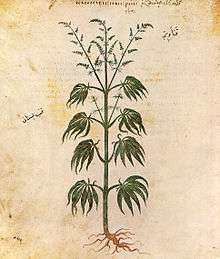
The Spaniards brought hemp to the Americas and cultivated it in Chile starting about 1545.[126] Similar attempts were made in Peru, Colombia, and Mexico, but only in Chile did the crop find success.[127] In July 1605, Samuel Champlain reported the use of grass and hemp clothing by the (Wampanoag) people of Cape Cod and the (Nauset) people of Plymouth Bay told him they harvested hemp in their region where it grew wild to a height of 4 to 5 ft. [128] In May 1607, "hempe" was among the crops Gabriel Archer observed being cultivated by the natives at the main Powhatan village, where Richmond, Virginia is now situated;[129] and in 1613, Samuell Argall reported wild hemp "better than that in England" growing along the shores of the upper Potomac. As early as 1619, the first Virginia House of Burgesses passed an Act requiring all planters in Virginia to sow "both English and Indian" hemp on their plantations.[130] The Puritans are first known to have cultivated hemp in New England in 1645.[126]
United States
George Washington pushed for the growth of hemp as it was a cash crop commonly used to make rope and fabric. In May 1765 he noted in his diary about the sowing of seeds each day until mid-April. Then he recounts the harvest in October which he grew 27 bushels that year.
It is sometimes supposed that an excerpt from Washington's diary, which reads "Began to seperate [sic] the Male from the Female hemp at Do.&—rather too late" is evidence that he was trying to grow female plants for the THC found in the flowers. However, the editorial remark accompanying the diary states that "This may arise from their [the male] being coarser, and the stalks larger"[131] In subsequent days, he describes soaking the hemp [132] (to make the fibers usable) and harvesting the seeds,[133] suggesting that he was growing hemp for industrial purposes, not recreational.
George Washington also imported the Indian Hemp plant from Asia, which was used for fiber and, by some growers, for intoxicating resin production. In a 1796 letter to William Pearce who managed the plants for him, Washington says, "What was done with the Indian Hemp plant from last summer? It ought, all of it, to be sown again; that not only a stock of seed sufficient for my own purposes might have been raised, but to have disseminated seed to others; as it is more valuable than common hemp."[134][135]
Other presidents known to have farmed hemp for alternative purposes include Thomas Jefferson,[136] James Madison, James Monroe, Andrew Jackson, Zachary Taylor, and Franklin Pierce. [137]
Historically, hemp production had made up a significant portion of antebellum Kentucky's economy. Before the American Civil War, many slaves worked on plantations producing hemp.[138]
In 1937, the Marihuana Tax Act of 1937 was passed in the United States, levying a tax on anyone who dealt commercially in cannabis, hemp, or marijuana. The passing of the Act to destroy the U.S. hemp industry has been disputed to involve businessmen Andrew Mellon, Randolph Hearst and the Du Pont family.[139][140][141]
One claim is that Hearst believed that his extensive timber holdings were threatened by the invention of the decorticator that he feared would allow hemp to become a cheap substitute for the paper pulp used for newspaper.[139][142] Historical research indicates this fear was unfounded because improvements of the decorticators in the 1930s – machines that separated the fibers from the hemp stem – could not make hemp fiber a cheaper substitute for fibers from other sources. Further, decorticators did not perform satisfactorily in commercial production.[143][139]
Another claim is that Mellon, Secretary of the Treasury and the wealthiest man in America at that time, had invested heavily in DuPont's new synthetic fiber, nylon, and believed that the replacement of the traditional resource, hemp, was integral to the new product's success.[139][144][145][146][147][148][149][150] The company DuPont and many industrial historians dispute a link between nylon and hemp, nylon became immediately a scarce commodity. Nylon had characteristics that could be used for toothbrushes (sold from 1938) and very thin nylon fiber could compete with silk and rayon in various textiles normally not produced from hemp fiber, such as very thin stockings for women.[143][151][152][153][154]
While the Marijuana Tax Act of 1937 had just been signed into law, the United States Department of Agriculture lifted the tax on hemp cultivation during WW II.[155] Before WW II, the U.S. Navy used Jute and Manila Hemp from the Philippines and Indonesia for the cordage on their ships. During the war, Japan cut off those supply lines.[156] America was forced to turn inward and revitalize the cultivation of Hemp on U.S. soils.
Hemp was used extensively by the United States during World War II to make uniforms, canvas, and rope.[157] Much of the hemp used was cultivated in Kentucky and the Midwest. During World War II, the U.S. produced a short 1942 film, Hemp for Victory, promoting hemp as a necessary crop to win the war.[156] U.S. farmers participated in the campaign to increase U.S. hemp production to 36,000 acres in 1942.[158] This increase amounted to more than 20 times the production in 1941 before the war effort.[158]
- History in the United States
 1942 United States Department of Agriculture War Board Letter of appreciation to Joe "Daddy Burt" Burton, a Kentucky hemp farmer for his support of the World War II Hemp for Victory campaign.[159]
1942 United States Department of Agriculture War Board Letter of appreciation to Joe "Daddy Burt" Burton, a Kentucky hemp farmer for his support of the World War II Hemp for Victory campaign.[159]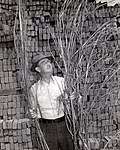 Joe "Daddy Burt" Burton, a recognized top Kentucky hemp farmer with harvested hemp, 1942. Photo by USDA War Board - Lexington, KY[160]
Joe "Daddy Burt" Burton, a recognized top Kentucky hemp farmer with harvested hemp, 1942. Photo by USDA War Board - Lexington, KY[160]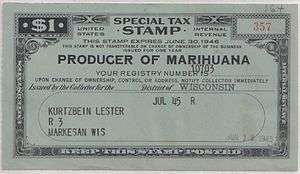 United States "Marihuana" production permit. In the United States, hemp cultivation is legally prohibited, but during World War II farmers were encouraged to grow hemp for cordage, to replace Manila hemp previously obtained from Japanese-controlled areas. The U.S. government produced a film explaining the uses of hemp, called Hemp for Victory.
United States "Marihuana" production permit. In the United States, hemp cultivation is legally prohibited, but during World War II farmers were encouraged to grow hemp for cordage, to replace Manila hemp previously obtained from Japanese-controlled areas. The U.S. government produced a film explaining the uses of hemp, called Hemp for Victory.
Historical cultivation
Hemp has been grown for millennia in Asia and the Middle East for its fibre. Commercial production of hemp in the West took off in the eighteenth century, but was grown in the sixteenth century in eastern England.[161] Because of colonial and naval expansion of the era, economies needed large quantities of hemp for rope and oakum. In the early 1940s, world production of hemp fiber ranged from 250 000 to 350 000 metric tonnes, Russia was the biggest producer.[143]
In Western Europe, the cultivation of hemp was not legally banned by the 1930s, but the commercial cultivation stopped by then, due to decreased demand compared to increasingly popular artificial fibers.[162] Speculation about the potential for commercial cultivation of hemp in large quantities has been criticized due to successful competition from other fibers for many products. The world production of hemp fiber fell from over 300,000 metric tons 1961 to about 75,000 metric tons in the early 1990s and has after that been stable at that level.[163]
Japan

In Japan, hemp was historically used as paper and a fiber crop. There is archaeological evidence cannabis was used for clothing and the seeds were eaten in Japan back to the Jōmon period (10,000 to 300 BC). Many Kimono designs portray hemp, or asa (Japanese: 麻), as a beautiful plant. In 1948, marijuana was restricted as a narcotic drug. The ban on marijuana imposed by the United States authorities was alien to Japanese culture, as the drug had never been widely used in Japan before. Though these laws against marijuana are some of the world's strictest, allowing five years imprisonment for possession of the drug, they exempt hemp growers, whose crop is used to make robes for Buddhist monks and loincloths for Sumo wrestlers. Because marijuana use in Japan has doubled in the past decade, these exemptions have recently been called into question.[164]
Portugal
The cultivation of hemp in Portuguese lands began around the fourteenth century. The raw material was used for the preparation of rope and plugs for the Portuguese ships. Portugal also utilized its colonies to support its hemp supply, including in certain parts of Brazil.[165]
In order to recover the ailing Portuguese naval fleet after the Restoration of Independence in 1640, King John IV put a renewed emphasis on the growing of hemp. He ordered the creation of the Royal Linen and Hemp Factory in the town of Torre de Moncorvo to increase production and support the effort.[166]
In 1971, the cultivation of hemp became illegal, and the production was substantially reduced. Because of EU regulations 1308/70, 619/71 and 1164/89, this law was revoked (for some certified seed varieties).[167]
See also
- Cannabis flower essential oil
- Fiber rope
- Hemp Industries Association
- Industrial Hemp Farming Act of 2009
- International Year of Natural Fibres
- Natural fibre
- Plant textiles
- The Emperor Wears No Clothes (book)
- Flax seed
References
- Swanson, TE (2015), "Controlled Substances Chaos: The Department of Justice's New Policy Position on Marijuana and What It Means for Industrial Hemp Farming in North Dakota" (PDF), North Dakota Law Review, 90 (3): 613CS1 maint: ref=harv (link)
- Robert Deitch (2003). Hemp: American History Revisited: The Plant with a Divided History. Algora Publishing. p. 219. ISBN 978-0-87586-226-2.
- Tourangeau, Wesley (2015), "Re-defining Environmental Harms: Green Criminology and the State of Canada's Hemp Industry", Canadian Journal of Criminology & Criminal Justice, 57 (4): 528–554, doi:10.3138/cjccj.2014.E11, S2CID 143126182
- Keller, NM (2013), "The Legalization of Industrial Hemp and What it Could Mean for Indiana's Biofuel Industry" (PDF), Indiana International & Comparative Law Review, 23 (3): 555, doi:10.18060/17887
- Johnson, Renée (22 March 2019). Defining Hemp: A Fact Sheet (PDF). Washington, DC: Congressional Research Service. Retrieved 29 March 2019.
- Swanson 2015, p. 602.
- Talbot, Geoff (2015). Specialty Oils and Fats in Food and Nutrition: Properties, Processing and Applications. Elsevier Science. p. 39. ISBN 978-1-78242-397-3.
- Crime, United Nations Office on Drugs and (2009). Recommended Methods for the Identification and Analysis of Cannabis and Cannabis Products: Manual for Use by National Drug Testing Laboratories. United Nations Publications. p. 12. ISBN 978-92-1-148242-3.
- Mallory, JP (1997), JP Mallory; DQ Adams (eds.), Encyclopedia of Indo-European Culture (Illustrated ed.), London, UK: Taylor & Francis, p. 266, ISBN 9781884964985
- Adams, DQ (2006), JP Mallory; DQ Adams (eds.), The Oxford Introduction to Proto-Indo-European and the Proto-Indo-European World, Oxford University Press, p. 166, ISBN 9780191058127
- Barber, EJW (1991), Prehistoric Textiles: The Development of Cloth in the Neolithic and Bronze Ages with Special Reference to the Aegean, Princeton University Press, pp. 36–38, ISBN 9780691002248
- McConvell, Patrick; Smith, Michael (2003), "Millers and Mullers: The archaeo-linguisitic stratigraphy of technological change in holocene Australia", in Henning Andersen (ed.), Language Contacts in Prehistory: Studies in Stratigraphy, John Benjamins Publishing, p. 181, ISBN 9781588113795
- "Erowid Cannabis Vault : Culture #2". erowid.org. Retrieved 20 June 2008.
- "Michael Karus: European Hemp Industry 2002 Cultivation, Processing and Product Lines. Journal of Industrial Hemp Volume 9 Issue 2 2004, Taylor & Francis, London". Informaworld.com. Cite journal requires
|journal=(help) - "America's First Hemp Drink - Chronic Ice - Making a Splash in the Natural Beverage Market". San Francisco Chronicle. Los Angeles. Vocus. 8 June 2011. Archived from the original on 27 December 2011. Retrieved 19 June 2011.
- "USDA ERS - Industrial Hemp in the United States: Status and Market Potential" (PDF). Ers.usda.gov. Archived from the original (PDF) on 25 June 2013. Retrieved 9 November 2013.
- "New York Chefs are Going Nuts for...Hemp Leaves?!". rachaelraymag.com. Retrieved 18 December 2018.
- "Farm bill promotes hemp as legal crop". Leg.state.or.us. Retrieved 5 February 2014.
- "Industrial fibre crops: business opportunities for farmers", gov.uk, Department for Environment, Food & Rural Affairs, 13 June 2013, retrieved 18 May 2016
- "Nutrition Facts for Hemp Seeds (shelled) per 100 g serving". Conde Nast, Custom Analysis. 2014. Retrieved 19 February 2015.
- Callaway, J. C. (1 January 2004). "Hempseed as a nutritional resource: An overview" (PDF). Euphytica. 140 (1–2): 65–72. doi:10.1007/s10681-004-4811-6. S2CID 43988645. Archived from the original (PDF) on 4 November 2013. Retrieved 13 March 2013.
- House JD, Neufeld J, Leson G (November 2010). "Evaluating the quality of protein from hemp seed (Cannabis sativa L.) products through the use of the protein digestibility-corrected amino acid score method". Journal of Agricultural and Food Chemistry. 58 (22): 11801–7. doi:10.1021/jf102636b. PMID 20977230.
- "CRRH, Archaeologists agree that cannabis was among the first crops cultivated by human beings at least over 6,000 years ago, and perhaps more than 12,000 years ago". Crrh.org. Retrieved 20 April 2011.
- "Online Etymology Dictionary". Etymonline.com. Retrieved 20 April 2011.
- Cronin, Mary Elizabeth (11 February 1995). "Hemp fashions are clean, comfy, and legal". The Free Lance-Star.
- "Going eco, going Dutch". Futuremakers.artez.nl. 17 July 2018. Retrieved 17 June 2019.
- NNFCC. "NNFCC Project Factsheet: Guide to Building with Hemp-Lime Composites, NNFCC 07-001", "National Non-Food Crops Centre", Retrieved on 16 February 2011
- "Why Build with Hemp? Properties of Hemp-Lime". OldBuilders. Retrieved 20 September 2018.
- Isabelle, Ceyte (2008). Etat, acteurs privés et innovation dans le domaine des matériaux de construction écologiques : Le développement du béton de chanvre depuis 1986 (PDF) (MASTER - Politiques publiques et gouvernements comparés thesis) (in French). 'Institut d'Etudes Politiques de Lyon.
- "The Haverhill Hemp Houses". bre.co.uk. Archived from the original on 6 September 2012. Retrieved 8 February 2013.
- "Modece Architects". modece.com. Archived from the original on 15 April 2013. Retrieved 8 February 2013.
- "The NNFCC Renewable House". Renewable-house.co.uk. Retrieved 20 April 2011.
- "Hemp homes are cutting edge of green building". USA Today. 12 September 2010.
- "HEMPSEC project website". European Union research. Retrieved 8 July 2014.
- Allin, Steve. Building with Hemp, Seed Press, 2012, ISBN 978-0-9551109-1-7. (p. 95, 2nd Edition).
-
"Thermoformable Composite Panels" (PDF). Composites World. 2006. Archived from the original (PDF) on 11 May 2008. Retrieved 3 July 2009. Cite journal requires
|journal=(help) - "Plastics". hemp.com. 14 May 2013. Retrieved 9 November 2013.
- "Lotus announces hemp-based Eco Elise: a new type of 'green' car". transport20.com. Archived from the original on 23 October 2013. Retrieved 9 November 2013.
- "Green Cars, Fuel Efficiency and the Environment | Mercedes-Benz". Mbusa.com. Retrieved 9 November 2013.
- "Michael Karus:European hemp industry 2001 till 2004: Cultivation, raw materials, products and trends, 2005" (PDF). Archived from the original (PDF) on 26 July 2011. Retrieved 20 April 2011.
- Paulapuro, Hannu (2000). "5". Paper and Board grades. Papermaking Science and Technology. 18. Finland: Fapet Oy. p. 114. ISBN 978-952-5216-18-9.
- Van Roekel; Gerjan J. (1994). "Hemp Pulp and Paper Production". Journal of the International Hemp Association.
- Van Roekel, Jr., Gertjan (1994). "Hemp Pulp and Paper Production". Journal of the International Hemp Association. 1: 12–14.
- "Hemp Harvest Management". Canadian Hemp Trade Alliance.
- "Hemp Fibre Production". Canadian Hemp Trade Alliance.
- MAŁACHOWSKA EDYTA, PRZYBYSZ PIOTR, DUBOWIK MARCIN, KUCNER MARTA, BUZAŁA KAMILA (2015). "Comparison of papermaking potential of wood and hemp cellulose pulps". Annals of Warsaw University of Life Sciences; SGGW Forestry and Wood Technology (91): 134–137.CS1 maint: multiple names: authors list (link)
- MAŁACHOWSKA EDYTA, PRZYBYSZ PIOTR, DUBOWIK MARCIN, KUCNER MARTA, BUZAŁA KAMILA (2015). "Comparison of papermaking potential of wood and hemp cellulose pulps". Annals of Warsaw University of Life Sciences; SGGW Forestry and Wood Technology (91): 134–137.CS1 maint: multiple names: authors list (link)
- MAŁACHOWSKA EDYTA, PRZYBYSZ PIOTR, DUBOWIK MARCIN, KUCNER MARTA, BUZAŁA KAMILA (2015). "Comparison of papermaking potential of wood and hemp cellulose pulps". Annals of Warsaw University of Life Sciences; SGGW Forestry and Wood Technology (91): 134–137.CS1 maint: multiple names: authors list (link)
- Small, E. and Marcus, D. with McElroy, A. (2002). "Hemp: A New Crop with New Uses for North America". American Society for Horticultural Science: 284–326.CS1 maint: multiple names: authors list (link)
- Small, E. and Marcus, D. with McElroy, A. (2002). "Hemp: A New Crop with New Uses for North America". American Society for Horticultural Science: 284–326.CS1 maint: multiple names: authors list (link)
- Schubert, Pit. "Our ropes are much stronger than we believe". Union Internationale Des Associations D'Alpinisme. Archived from the original on 27 September 2007.
- NNFCC. In the US, pet manufacturers use hemp in dog and cat bedding. "Crop Factsheet: Hemp" Archived 26 March 2009 at the Wayback Machine, National Non-Food Crops Centre, 9 June 2008. Retrieved on 6 May 2009
- "Phytoremediation: Using Plants to Clean Soil". Mhhe.com. Retrieved 20 April 2011.
- "Hemp As Weed Control". gametec.com. Retrieved 9 July 2008.
- Reisinger, Péter; Lehoczky, Éva; Komives, Tamas (1 March 2005). "Competitiveness and Precision Management of the Noxious Weed Cannabis sativa L. in Winter Wheat". Communications in Soil Science and Plant Analysis. 36 (4–6): 629–634. doi:10.1081/CSS-200043303. ISSN 0010-3624. S2CID 96007971.
- "COOLFUEL Episode: Sugarcane and Hempoline". Retrieved 16 October 2009.
- "Clean Energy Solutions". Hemp 4 Fuel. Retrieved 20 April 2011.
- "Pollution: Petrol vs. Hemp". Hempcar.org. Archived from the original on 20 July 2006. Retrieved 20 April 2011.
- "Biofuels Facts". Hempcar.org. Archived from the original on 20 May 2011. Retrieved 20 April 2011.
- "Increased biogas production at the Henriksdals Waste Water plant, Cajsa Hellstedt et. all, June 2010" (PDF).
- What Farmers Need to Know About Growing Hemp(https://www.agriculture.com)|date=22 July 2019 }}
- Cornbread, Hemp. "Kentucky Grown Hemp Since 1775". cornbreadhemp.com. Cornbread Hemp. Retrieved 14 June 2020.
- Arnone, Vince (24 July 2018). "Hemp vs Marijuana: The Important Differences Explained". Big Sky Botanicals. Retrieved 21 May 2020.
- Adams, Cydney (17 November 2016). "The man behind the marijuana ban for all the wrong reasons". CBS News. Retrieved 28 March 2019.
- This paper begins with a history of hemp use and then describes how hemp was constructed as a dangerous crop in the U.S. The paper then discusses the potential of hemp as an alternative crop. Luginbuhl, April M. (2001). "Industrial hemp (Cannabis sativa L): The geography of a controversial plant". The California Geographer. 41. California Geographical Society. pp. 1–14. hdl:10211.2/2738.
Hemp contains less than 1% THC, or tetrahydrocannabinols, the psychoactive property in marijuana. In other words, smoking hemp cannot create a 'high.' ... The dense growth of hemp eliminates other weeds.... The best growing technique for hemp, planting 300 to 500 plants per square meter, also helps authorities easily tell the hemp from marijuana, which is a plant that is less densely cultivated. (Roulac 1997; 149).
- Deitch, Robert (2003). Hemp: American History Revisited: The Plant with a Divided History. Algora Publishing. pp. 4–26. ISBN 9780875862262. Retrieved 16 November 2013.
Cannabis is ... a plant that played an important role in colonial America's prosperous economy and remained a valuable commercial commodity up until the Second World War.
- ADAS (July 2005). "UK Flax and Hemp production: The impact of changes in support measures on the competitiveness and future potential of UK fibre production and industrial use" (PDF). Department for Environment, Food and Rural Affairs. Archived from the original (PDF) on 4 November 2013. Retrieved 14 June 2013.
- "Industrial Hemp Production and Management". Province of Manitoba: Manitoba Agriculture. Archived from the original on 13 December 2019. Retrieved 8 January 2019.
- Sawler, J; Stout, J. M; Gardner, K. M; Hudson, D; Vidmar, J; Butler, L; Page, J. E; Myles, S (2015). "The Genetic Structure of Marijuana and Hemp". PLOS ONE. 10 (8): e0133292. Bibcode:2015PLoSO..1033292S. doi:10.1371/journal.pone.0133292. PMC 4550350. PMID 26308334.
- Elsohly, M. A; Radwan, M. M; Gul, W; Chandra, S; Galal, A (2017). Phytochemistry of Cannabis sativa L. Progress in the Chemistry of Organic Natural Products. 103. pp. 1–36. doi:10.1007/978-3-319-45541-9_1. ISBN 978-3-319-45539-6. PMID 28120229.
- Datwyler, SL; Weiblen, GD (2006). "Genetic Variation in Hemp and marijuana (Cannabis sativa L.) sativa plants are taller and less dense. Indica plants are shorter but a lot more dense than sativas. According to Amplified Fragment Length Polymorphisms". Journal of Forensic Sciences. 51 (2): 371–375. doi:10.1111/j.1556-4029.2006.00061.x. PMID 16566773. S2CID 3145952.
- Hemp and Marijuana: Myths & Realities written by David P. West, Ph.D. for the North American Industrial Hemp Council
- "Cannabis pests". www.internationalhempassociation.org. Retrieved 22 July 2020.
- Cranshaw, Whitney; Schreiner, Melissa; Britt, Kadie; Kuhar, Thomas P.; McPartland, John; Grant, Jerome (1 January 2019). "Developing Insect Pest Management Systems for Hemp in the United States: A Work in Progress". Journal of Integrated Pest Management. 10 (1). doi:10.1093/jipm/pmz023.
- Common, Michael; Stagl, Sigrid; Gay, Philip W. (30 June 1998). "Industrial hemp's double dividend: a study for the USA". Ecological Economics. 25 (3): 291–301. CiteSeerX 10.1.1.603.9935. doi:10.1016/S0921-8009(97)00040-2.
- Da Silva Vieira, Ricardo; Canaveira, Paulo; Da Simões, Ana; Domingos, Tiago (2010). "Industrial hemp or eucalyptus paper?". The International Journal of Life Cycle Assessment. 15 (4): 368–375. doi:10.1007/s11367-010-0152-y. S2CID 108608835.
- "FAQs & Facts: Facts". Resources: Education. The HIA. Archived from the original on 10 July 2008. Retrieved 5 July 2008.
- "HIA: Resources: Education: FAQs & Facts: FAQs: Answers". thehia.org. Archived from the original on 10 October 2013. Retrieved 5 July 2008.
- "D. Risula, and others, Saskatchewan Ministry of Agriculture, October 2009". Archived from the original on 26 August 2011. Retrieved 20 April 2011.
- "Lawmakers legalize industrial hemp farming in Greece: Prospects & Opportunities". Tekmon Geomatics. Archived from the original on 6 February 2017. Retrieved 5 February 2017.
- "Hemp vs. Marijuana". azhemp.org. Archived from the original on 9 May 2003. Retrieved 18 June 2008.
- "Hemp Facts". thehia.org. Archived from the original on 27 September 2013. Retrieved 9 November 2013.
- Carus, Michael (June 2013). "The European Hemp Industry: Cultivation, processing and applications for fibres, shivs and seeds" (PDF). European Industrial Hemp Association. Retrieved 30 August 2016.
- "Agriculture in the European Union, Statistical and Economic Information 2011, European Union Directorate-General for Agriculture and Rural Development, page 283" (PDF). Retrieved 9 November 2013.
- "Growing Industrial Hemp in Ontario, Ministry of Agriculture, Food and Rural Affairs, Canada, 2008". ON, CA: Omafra. Retrieved 20 April 2011.
- Graeme Thomas. "Natural Fibers: Hemp Food and Agriculture Organization of the United Nations, 2009". Naturalfibres2009.org. Retrieved 20 April 2011.
- "Drugs, Poisons and Controlled Substances (Industrial Hemp) Regulations 2008" (PDF). dms.dpc.vic.gov.au. Archived from the original (PDF) on 17 December 2008. Retrieved 24 November 2008.
- "Guidelines for engaging in the commercial production of industrial hemp in Queensland". dpi.qld.gov.au. Archived from the original on 20 December 2008. Retrieved 24 November 2008.
- "Drugs Misuse Act 1986" (PDF). legislation.qld.gov.au. Retrieved 24 November 2008.
- "Western Australian Legislation - Industrial Hemp Act 2004". www.legislation.wa.gov.au. Retrieved 5 August 2019.
- "Opportunities to engage in commercial low THC hemp fibre and seed production in NSW". dpi.nsw.gov.au. Archived from the original on 24 December 2008. Retrieved 24 November 2008.
- "Hemp Industry Regulation 2008". legislation.nsw.gov.a. Retrieved 24 November 2008.
- "Archived copy". Archived from the original on 26 November 2018. Retrieved 26 November 2018.CS1 maint: archived copy as title (link)
- "Government of Alberta: Industrial Hemp Production in Canada, February 2, 2010". .agric.gov.ab.ca. Retrieved 20 April 2011.
- "Where the heck is hemp?, The Alberta Express, April 18th, 2007". www.hempline.com.
- "Manitoba Harvest 2007 Peoples Choice, Eco Libris, Oct 8th, 2007". ecolibris.blogspot.ca/.
- Mark Halsall (2 March 2018). "Hemp area may stall in 2018". CountryGuide, Glacier FarmMedia Limited Partnership. Retrieved 18 May 2018.
- "Hemp: a plant still unknown (in French)". Jardinage. 4 October 2014. Retrieved 25 June 2018.
- Jordbruksverket: 2.1–2.3, 2.5 Marknadssituationen för spannmål, oljeväxter, proteingrödor, ris,2011-03-10, (Swedish Board of Agriculture, Report from an expert group in the European Union about the market situation for a number of agricultural products. Published only in Swedish) Archived 18 January 2012 at the Wayback Machine
- "Hemp research and growing in Ukraine". Aginukraine.com. 6 January 2002. Retrieved 20 April 2011.
- Hemp will help Ukraine to grow wealthy Archived 13 October 2008 at the Wayback Machine (in Russian)
- Interview with Dr. V. G. Virovets, the head of the Hemp Breeding Department at the Institute of Bast Crops Archived 8 March 2008 at the Wayback Machine (1998) (in English)
- "(Website/ Products)". Retrieved 28 September 2011.
- Jon Merrills; Jonathan Fisher (2013). Pharmacy Law and Practice. Academic Press. p. 227. ISBN 978-0-12-394618-8.
- Dyer, Owen (31 May 2018). "Trump signs bill to give patients right to try drugs". BMJ. 361: k2429. doi:10.1136/bmj.k2429. ISSN 0959-8138. PMID 29853541. S2CID 46918623.
- "State Industrial Hemp Statutes". ncsl.org. Retrieved 12 December 2019.
- Oregon Department of Agriculture (6 August 2009). "Industrial Hemp in Oregon" (PDF). library.state.or.us. Retrieved 20 April 2019.
- Stoller, Joyce (7 March 1996). "Hemp, Hemp, Hooray!". Monthly Review. 47 (10): 58. doi:10.14452/mr-047-10-1996-03_7. ISSN 0027-0520.
- Congress of the United States of America (3 January 2014). "Agricultural Act of 2014" (PDF). govinfo.org. Retrieved 20 April 2019.
- "Student Pugwash USA announces science and politics multimedia contest winners". Physics Today. 2013. doi:10.1063/pt.4.1568. ISSN 1945-0699.
- Windham, Lane (18 January 2018). "Signing Up in the Shipyard". 1. University of North Carolina Press. doi:10.5149/northcarolina/9781469632070.003.0005. Cite journal requires
|journal=(help) - "Geology of the Moses Lake North quadrangle, Washington". 1961. doi:10.3133/i330. Cite journal requires
|journal=(help) - Schafer, Roy (26 March 2018), "You can get here from there", Tragic Knots in Psychoanalysis, Routledge, pp. 155–167, doi:10.4324/9780429484155-10, ISBN 9780429484155
- Hemp Business journal (13 June 2018). "The U.S. Hemp Industry grows to $820mm in sales in 2017". hempbizjournal.com. Retrieved 12 December 2019.
- Chhabra, Esha (10 July 2015). "Downside of becoming a richer country". BMJ. 351: h3759. doi:10.1136/bmj.h3759. ISSN 1756-1833. PMID 26162376. S2CID 29362743.
- Stafford, Peter (1992). Psychedelics Encyclopedia. Berkeley, CA, USA: Ronin Publishing. ISBN 978-0-914171-51-5.
- "Information paper on industrial hemp (industrial cannabis)". Department of Primary Industries and Fisheries, Queensland Government. Archived from the original on 23 July 2008. Retrieved 5 July 2008.
- Ethan Russo (August 2007). "History of cannabis and its preparations in saga, science, and sobriquet". Chemistry & Biodiversity. 4 (8): 1614–1648. doi:10.1002/cbdv.200790144. PMID 17712811. S2CID 42480090.
- Tengwen Long; et al. (March 2017). "Cannabis in Eurasia: origin of human use and Bronze Age trans-continental connections". Vegetation History and Archaeobotany. 26 (2): 245–258. doi:10.1007/s00334-016-0579-6. S2CID 133420222.
- Barber, E. J. W. (1992). Prehistoric Textiles: The Development of Cloth in the Neolithic and Bronze Ages with Special Reference to the Aegean. Princeton University Press. p. 17.
- Herodotus. Histories. IV. 73–75.
- Barber, E. J. W. (1992). Prehistoric Textiles: The Development of Cloth in the Neolithic and Bronze Ages with Special Reference to the Aegean. Princeton University Press. p. 18.
- Barber (1992). p. 19.
- Regional Cuisines of Medieval Europe: A Book of Essays (2002), edited by Melitta Weiss Adamson, ISBN 0-415-92994-6, pg. 98, 166
- Daryl T. Ehrensing (May 1998). "Feasibility of Industrial Hemp Production in the United States Pacific Northwest, SB681". Oregon State University. Retrieved 15 May 2016.
- Gabriel G. Nahas (31 December 1992). Cannabis Physiopathology Epidemiology Detection. CRC Press. pp. 210–. ISBN 978-0-8493-8310-6.
- Champlain, Samuel, Henry P. Biggar. 1929. The Works of Samuel de Champlain, vol 1. Toronto: Champlain Society. pp. 341–56.
- Gabriel Archer, A Relatyon of the Discoverie of Our River..., printed in Archaeologia Americana 1860, p. 44. William Strachey (1612) records a native (Powhatan) name for hemp (weihkippeis).
- Proceedings of the Virginia Assembly, 1619 Archived 4 March 2003 at the Wayback Machine, cf. the 1633 Act: Hening's Statutes at Large, p. 218
- "Diary of George Washington, entry 7 August 1765". founders.archives.gov. Retrieved 3 June 2014.
- "Diary of George Washington, entry 22 August 1765". founders.archives.gov. Retrieved 3 June 2014.
- "Diary of George Washington, entry September 1765". founders.archives.gov. Retrieved 3 June 2014.
- "From George Washington to William Pearce, 29 May 1796". Founders Online. National Archive. Retrieved 15 September 2019.
- Robinson, Rowan (1996). The Great Book of Hemp: The Complete Guide to the Environmental, Commercial, and Medicinal Uses of the World's Most Extraordinary Plant. Rochester, Vermont: Park Street Press. p. 131. ISBN 9780892815418. Retrieved 15 September 2019.
- Bear, James A. Jr., and Lucia C. Stanton, eds. Jefferson's Memorandum Books: Accounts, with Legal Records and Miscellany, 1767–1826. Princeton, NJ: Princeton University Press, 1997, 1:383.
- Robinson, Rowan. The Great Book of Hemp: The Complete Guide to the Environmental, Commercial, and Medicinal Uses of the World's Most Extraordinary Plant. Rochester, VT. Park Street Press, 2010. Chapter 5:129-135. Print
- James F. Hopkins, "Slavery in the Hemp Industry", Drug Library
- French, Laurence; Manzanárez, Magdaleno (2004). NAFTA & neocolonialism: comparative criminal, human & social justice. University Press of America. p. 129. ISBN 978-0-7618-2890-7.
- Earlywine, 2005: p. 24
- Peet, 2004: p. 55
- Sterling Evans (2007). Bound in twine: the history and ecology of the henequen-wheat complex for Mexico and the American and Canadian Plains, 1880–1950. Texas A&M University Press. p. 27. ISBN 978-1-58544-596-7.
- Dewey LH (1943). Fiber production in the western hemisphere. United States Printing Office, Washington. p. 67. Retrieved 25 February 2015.
- Evans, Sterling, ed. (2006). The borderlands of the American and Canadian Wests: essays on regional history of the forty-ninth parallel. University of Nebraska Press. p. 199. ISBN 978-0-8032-1826-0.
- Gerber, Rudolph Joseph (2004). Legalizing marijuana: drug policy reform and prohibition politics. Greenwood Publishing Group. p. 7. ISBN 978-0-275-97448-0.
- Earleywine, Mitchell (2005). Understanding marijuana: a new look at the scientific evidence. Oxford University Press. p. 231. ISBN 978-0-19-518295-8.
- Robinson, Matthew B; Scherlen, Renee G (2007). Lies, damned lies, and drug war statistics: a critical analysis of claims made by the office of National Drug Control Policy. SUNY Press. p. 12. ISBN 978-0-7914-6975-0.
- Rowe, Thomas C (2006). Federal narcotics laws and the war on drugs: money down a rat hole. Psychology Press. p. 26. ISBN 978-0-7890-2808-2.
- Sullivan, Larry E; et al., eds. (2005). Encyclopedia of Law Enforcement: Federal. SAGE. p. 747. ISBN 978-0-7619-2649-8.
- Lusane, Clarence (1991). Pipe dream blues: racism and the war on drugs. South End Press. pp. 37–8. ISBN 978-0-89608-410-0.
- "the history of nylon". caimateriali.org.
- Wolfe, Audra J. (2008). "Nylon: A Revolution in Textiles". Chemical Heritage Magazine. 26 (3). Retrieved 20 March 2018.
- "American Chemical Society: THE FIRST NYLON PLANT. 1995" (PDF). acs.org.
- "Who invented the toothbrush and when was it? (Everyday Mysteries: Fun Science Facts from the Library of Congress)". loc.gov.
- Klonoff, Harry (1974). "The Logistics of Marijuana Research: Methodological, Legal, and Societal". Marijuana: Effects on Human Behavior. Elsevier. pp. 1–24. doi:10.1016/b978-0-12-497050-2.50006-1. ISBN 9780124970502.
- USDA (1942). Hemp for Victory. Event occurs at 1:40. Retrieved 25 April 2019.
- "Chapter 5. The Wartime Transformation of Student Visitors into Refugee Citizens, 1943–1955". The Good Immigrants: How the Yellow Peril Became the Model Minority. Princeton University Press. 31 January 2015. pp. 104–129. doi:10.1515/9781400866373-009. ISBN 9781400866373.
- USDA (1942). Hemp for Victory. Event occurs at 2:05. Retrieved 25 April 2019.
- Letter to Daddy Burt from USDA War Board | Burton Family Archive: Sallyann Burton Gullett
- Picture of Daddy Burt with harvested hemp | Burton Family Archive: Jimmy Wallace Bruner
- Bradshaw, R. H. W.; Coxon, P.; Greig, J. R. A.; Hall, A. R. (1981). "New Fossil Evidence for the Past Cultivation and Processing of Hemp (Cannabis sativa L.) in Eastern England". The New Phytologist. 89 (3): 503–510. doi:10.1111/j.1469-8137.1981.tb02331.x. JSTOR 2434380.
- "Dr. Ivan BÛcsa, GATE Agricultural Research Institute, Kompolt - Hungary, Book Review Re-discovery of the Crop Plant Cannabis Marihuana Hemp (Die Wiederentdeckung der Nutzplanze Cannabis Marihuana Hanf)". Hempfood.com. Archived from the original on 21 December 2012. Retrieved 20 April 2011.
- Lynn Robins; et al. (July 2013). "Economic Considerations for Growing Industrial Hemp:Implications for Kentucky's Farmers and Agricultural Economy" (PDF). Department of Agricultural Economics, University of Kentucky. Archived from the original (PDF) on 4 April 2015. Retrieved 29 March 2015.
- Yuka Hayashi (4 March 2009). "In Drug-Leery Japan, Arrests for Marijuana Are on the Rise". Wall Street Journal.
- Verto, Abbé; de Boisgelin, Louis (1809). The History of the Revolutions of Portugal. London. p. 363 – via Project Gutenberg.
- "Torre de Moncorvo". Visit Portugal. Turismo de Portugal. 2013. Retrieved 20 April 2019.
- Schütze, Robert (2018). "Regulation 182/2011 Laying Down the Rules and General Principles Concerning Mechanisms for Control by Member States of the Commissions Exercise of Implementing Powers (Comitology Regulation)". EU Treaties and Legislation. Cambridge University Press. pp. 272–280. doi:10.1017/9781108624374.008. ISBN 9781108624374.
External links
| Wikiquote has quotations related to: Cannabis |
| Wikimedia Commons has media related to Hemp. |
| Look up hemp in Wiktionary, the free dictionary. |
- Industrial Hemp in the United States: Status and Market Potential (www.ers.usda.gov)
- . New International Encyclopedia. 1905.